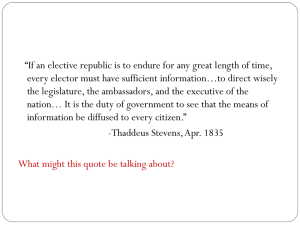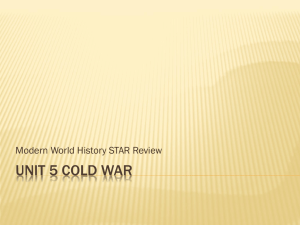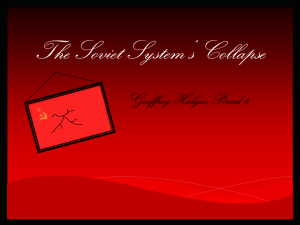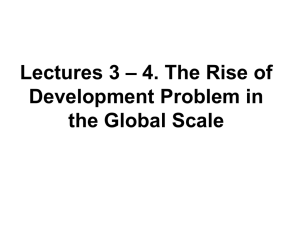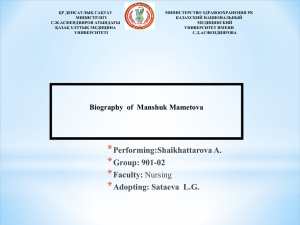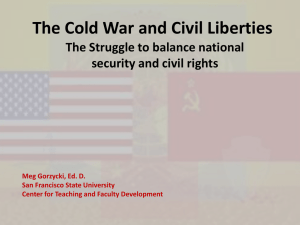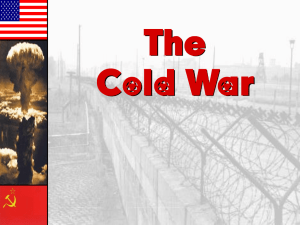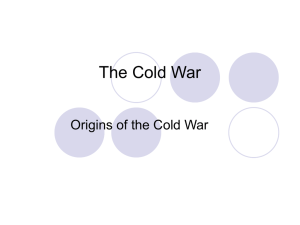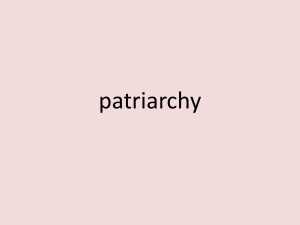USG Chapter 26
advertisement
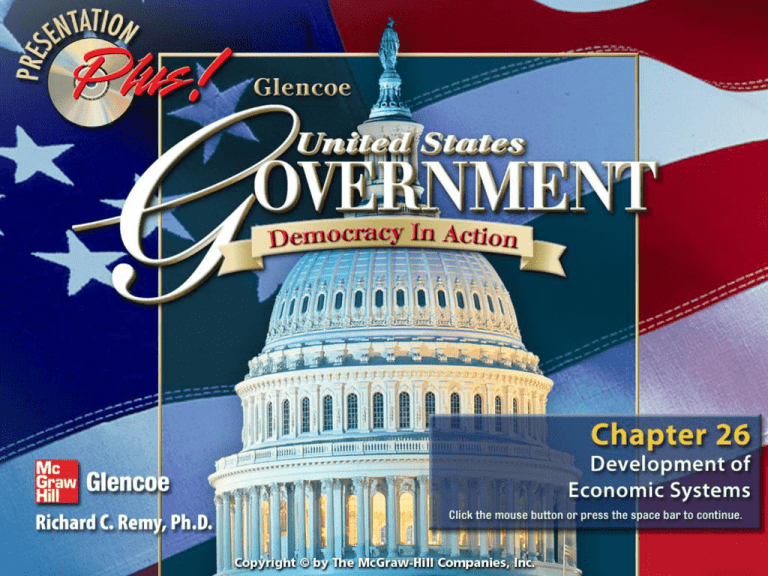
Chapter Focus Section 1 Capitalist and Mixed Systems Section 2 Emerging Economies Section 3 Major Economies in Transition Section 4 The Global Economy Chapter Assessment Chapter Objectives • Capitalist and Mixed Systems Identify the factors of production in economic systems and the chief characteristics of capitalism. • Emerging Economies Discuss economic problems that have challenged developing nations and attempts to solve those problems. • Major Economies in Transition Describe the major obstacles to change in the Russian and Chinese economies. • The Global Economy Analyze the factors that dominate global economic concerns today. Capitalist and Mixed Systems Key Terms scarcity, traditional economy, command economy, market economy, factors of production, entrepreneur, monopoly, profit, mixed economy Find Out • What are the characteristics of capitalism that differentiate it from socialism and communism? • Why can the economy of the United States be called a mixed economy? Capitalist and Mixed Systems Understanding Concepts Free Enterprise What kinds of economic choices do individuals make in a free enterprise system? Section Objective Identify the factors of production in economic systems and the chief characteristics of capitalism. In 1776 Adam Smith described capitalism as an economic system controlled by an “invisible hand.” According to Smith, through self interest this invisible hand moves people to decide what goods and services to produce, how to produce them, and to whom to distribute them. Adam Smith’s ideas were popularized in his book The Wealth of Nations, which was published in the same year the United States declared its independence. I. Factors of Production (pages 717–718) A. The resources of an economic system are called factors of production. B. Factors of production fall into four categories: 1) land, 2) labor, 3) capital, 4) entrepreneurs. I. Factors of Production (pages 717–718) Are all of the factors of production equally important in the economy? Explain. If any factor is less important, it is still essential to production. II. Forms of Economic Organization (page 718) A. Three major forms of economic organization represent the range of economic systems that determine how the factors of production are allocated. B. Communism is a command economic system. C. Socialism is a partial command economic system. D. Capitalism is an economic system in which individual producers and consumers make the economic decisions in free markets. II. Forms of Economic Organization (page 718) II. Forms of Economic Organization (page 718) What do you think are the advantages and disadvantages of a communist system? Explain. Answers will vary. Lack of incentives, central planning, little individual freedom. III. Characteristics of Capitalism (pages 718–721) A. In the United States and several industrial countries, capitalism is the basic economic system. B. Capitalism, also called a free enterprise system, is based on private ownership and on individual economic freedom. C. Capitalists range from small store owners, persons who own a few shares of stock in a corporation, to industrialists who own large factories, mines, and financial institutions. D. Capitalism encourages people to become entrepreneurs. III. Characteristics of Capitalism (pages 718–721) E. Competition among sellers of products and services is another characteristic of capitalism. F. Buyers, sellers, and workers have freedom of choice in a capitalist system. G. The capitalist system is based on the profit motive. III. Characteristics of Capitalism (pages 718–721) What do you think are the advantages and disadvantages of a capitalist system? Answers will vary. Free enterprise, private ownership, individual initiative, competition. IV. Changing Face of Capitalism (page 721) A. Capitalism in the United States contains some elements of a command economy. B. Since the late 1800s, the federal government has increased its role in the economy. C. The federal government has adopted regulatory laws to ensure competition and safety. IV. Changing Face of Capitalism (page 721) D. In Japanese capitalism, the government works closely with business to limit foreign competition. In South Korea, Singapore, and Taiwan the government has a similar close relationship with business. E. Generally, the capitalist economies of Western European nations are more controlled and regulated than that of the United States. IV. Changing Face of Capitalism (page 721) How might the relationship between government and business change in capitalist nations during the twentyfirst century? Answers will vary. Discuss the increasing or decreasing role of government in economies. Checking for Understanding 1. Main Idea Use a graphic organizer like the one below to identify five characteristics of capitalist economies. private ownership, individual initiative, competition, freedom of choice, profit and loss Checking for Understanding Match the term with the correct definition. ___ B scarcity ___ C entrepreneur ___ D monopoly ___ A profit A. the difference between the amount of money used to operate a business and the amount of money a business takes in B. a condition that exists because society does not have all the resources to produce all the goods and services that everyone wants C. a person who takes a risk to produce goods and services in search of profit D. a business that controls so much of an industry that little or no competition exists Checking for Understanding 3. Identify communism, socialism, capitalism, free enterprise system. Communism is an economic system in which the central government directs all major economic decisions. Socialism is an economic system in which the government owns the basic means of production, distributes the products and wages, and provides social services such as health care and welfare. Capitalism is an economic system providing free choice and individual incentive for workers, investors, consumers, and business enterprises. A free enterprise system is an economic system based on private ownership of the means of production and on individual economic freedom. Checking for Understanding 4. What are the three forms of economic organization that have emerged in the world? Communism, socialism, and capitalism are the three forms of economic organization that have emerged in the world. Checking for Understanding 5. How has the U.S. government played a growing role in the nation’s economy since the late 1800s? It has taken responsibility for the well-being of individuals and for the financial condition of the nation. It has assumed increasing responsibility for social policies. Critical Thinking 6. Making Inferences How does the free market system promote freedom of choice for consumers in the United States? Consumers are free to choose what products they buy. Consumers may choose from a variety of sellers and products. Free Enterprise One of the issues debated by advocates of a planned economy and those who support a free market economy is whether there can be democratic freedoms such as freedom of speech without having economic freedom. Write an essay explaining the connection between economic freedom and civil liberties. Emerging Economies Key Terms developing nations, newly developed nations, welfare state, nationalization Find Out • What are the important economic choices that developing and newly developed nations must make? • How have economic choices affected the development of nations in Latin America and Africa? Emerging Economies Understanding Concepts Comparative Government What are the differences and similarities of socialist governments and communist governments? Section Objective Discuss economic problems that have challenged developing nations and attempts to solve those problems. As many Latin American nations developed their economies, land reform turned some toward socialism. In Chile, a socialist government led by Salvador Allende began an ambitious program to break up large land holdings and redistribute land to the people. In 1973 the army overthrew Allende, established a military government, and ended land reform and socialism in Chile. I. Developing and Newly Developed Nations (page 772) A. Developing nations are states with little or no industry. B. Newly developed nations are states that have had significant or rapid industrial growth in recent years. I. Developing and Newly Developed Nations (page 772) I. Developing and Newly Developed Nations (page 772) If you were the leader of a newly developing nation, what economic model would you want to follow? Explain. Answers will vary. Discuss capitalism, socialism, or a mixed system. II. The Economic Choices (pages 722–724) A. Some developing and newly developed nations rely on the free market, trade and contacts with the West to develop their economies; others rely on socialist economic models. B. Under socialism the government only owns and controls some factors of production. C. Socialists believe that wealth should be distributed as equally as possible. They try to achieve this goal by making basic goods and social services available to everyone. D. Critics of socialism claim socialist policies create a welfare state. II. The Economic Choices (pages 722–724) Do you think government should have a major role in the economy? Why or why not? Answers will vary. Discuss advantages of specific services and regulations of government. III. Searching for Economic Answers (pages 724–726) A. Socialist governments in developing and newly developed countries use more central planning than developed socialist countries do. B. Socialist governments often take control of industries by nationalization. C. Many developing nations, especially in Latin America, have a history of foreignowned industries. D. Nationalization in Latin America has been both an economic policy and a symbol of anti-colonialism. III. Searching for Economic Answers (pages 724–726) E. Until recent moves toward free enterprise, Israel had a moderate socialist economy. F. After independence, many African nations tried to develop economies based on one cash crop or one resource for trade. G. Economic difficulties forced African countries south of the Sahara to take on $130 billion worth of debt by the 1980s. III. Searching for Economic Answers (pages 724–726) How do you think central planning by the government can be helpful in a developing nation? Answers will vary. See Searching for Economic Answers on text page 724. IV. Socialism’s Practical Problems (page 726) A. Socialist ideology remains a popular and widely held belief in the developing world. B. Socialism often fails to live up to its promises because capital investment is a primary need for developing economies. Failure of large-scale economic planning in Eastern Europe has raised doubts that it can work. C. Western governments have exercised influence and pressure in favor of a combination of free markets and democracy in developing nations. IV. Socialism’s Practical Problems (page 726) How do you think the socialist model can be improved? Answers will vary. See Socialism’s Practical Problems on text page 726. Checking for Understanding 1. Main Idea Create a graphic organizer like the one below. In the left box, identify the economic issues facing developing countries. In the right box, list policies some have adopted to promote economic progress. Answers might include: Issues—foreign ownership of industry, how to achieve rapid industrial growth, development of cash crops for export; Policies—nationalization of industry, centralized planning, agricultural communes, acceptance of foreign aid and loans Checking for Understanding Match the term with the correct definition. ___ C developing nations ___ A newly developed nations ___ D welfare state ___ B nationalization A. nations that have had significant or rapid industrial growth in recent years B. the process by which a government takes control of industry C. nations only beginning to develop industrially D. a nation that has an economic system that provides many welfare programs Checking for Understanding 3. Identify centralized planning, kibbutzim. Centralized planning is government control of the economy. Kibbutzim are collective agricultural communes. Checking for Understanding 4. Why have many Latin American industries been foreign-owned? Many Latin American industries have been foreign-owned because of their colonial history or their reliance upon foreign investment. Checking for Understanding 5. What factor contributes to socialism in Africa? Some African leaders adopted socialism because they viewed Western capitalism as another form of colonialism. Critical Thinking 6. Making Comparisons Analyze the economic choices that developing and newly developed nations must make in an increasingly interdependent global economy. Developing nations may seek to industrialize as rapidly as possible, whereas newly developed nations may seek to sustain their rate of growth and influence the world economy. Comparative Government Review the characteristics of economies under socialist governments and under communist governments. Create an organizational chart that illustrates decision making under each of these types of government. Major Economies in Transition Key Terms state farm, collective farm, gross national product Find Out • How did economic problems lead to the collapse of the Soviet Union? • What are some of the obstacles to change faced by Russia? Major Economies in Transition Understanding Concepts Comparative Government How did the Communist Party control the government and economy of the Soviet Union? Section Objective Describe the major obstacles to change in the Russian and Chinese economies. After decades in power, the Communist Party was unable to prevent the breakdown of the authoritarian economic and political system of the Soviet Union. Mikhail Gorbachev’s efforts to reform the communist system failed. As a leading adviser of Gorbachev had predicted, “Gorbachev took on this country like my wife takes on cabbage. He thought that to get rid of the dirt, he could just peel off the top layers of the leaves. But he had to keep going until there was nothing.” I. Transforming the Russian Economy (pages 728–729) A. Beginning in 1917, the Soviet Union built the world’s leading communist economic system; economic decisions were made by the government. Almost all Soviet enterprises and farms were state-owned and state-operated. B. Mikhail Gorbachev, the last Communist leader of the Soviet Union, tried to change many policies to stimulate the stagnating economy, but the economy continued to decline. C. Gorbachev resigned in 1991; several Soviet republics then declared their independence, effectively ending the Soviet Union. I. Transforming the Russian Economy (pages 728–729) D. Since the collapse of communism, Russian leaders have made attempts to move toward capitalism and democracy. E. Even with some reform, Russia is being run much as it was under communism—and by many of the same leaders. F. The slow pace of change in Russia has several causes. For one, former Communist bureaucrats are unwilling to give up power. Also, Russians are familiar with living in a society in which rules have traditionally been imposed from above. I. Transforming the Russian Economy (pages 728–729) Do you think that Russia can overcome the problems it faces today? Explain your answer. Answers will vary. Have students assess the current Russian economic and political situation. II. Changing the Chinese Economy (pages 729–731) A. The Chinese Communist government followed the model of the Soviet planned economy until China found itself unable to compete with the market-based economies of its neighbors. B. In the late 1970s, China’s Communist leaders began to encourage private enterprise; since then, the Chinese economy has grown rapidly. II. Changing the Chinese Economy (pages 729–731) C. More recent rapid development in China has several causes: i. China’s population provides a large labor pool. ii. The Chinese government promotes manufacturing by giving foreign companies tax incentives and cheap land. iii. The Chinese government spends billions of dollars on communications technologies to assist manufacturers. II. Changing the Chinese Economy (pages 729–731) D. China is attempting to move to a market economy while maintaining an authoritarian political system controlled by the Communist Party. E. Several factors threaten the Communist Party in China: i. China’s growing middle class will want more of a say in its government. ii. Poverty and unemployment creates a class of urban poor who are angry with the government. iii. Transition to a market economy has led to even greater political corruption. II. Changing the Chinese Economy (pages 729–731) F. Trade with China has opened new markets for American goods, though Chinese labor costs have driven many American manufacturers out of business. American experts worry that an economically strong China could become a dangerous political and military rival. II. Changing the Chinese Economy (pages 729–731) Do you think that rapid economic growth in China will have a positive or negative impact on the United States? Explain your answer. Answers will vary. Students should illustrate an understanding of the impact of an economically strong China on American business and industry. Checking for Understanding 1. Main Idea Use a graphic organizer like the one here to identify four reasons for China’s rapid economic growth. large labor pool, low production costs, tax breaks and cheap land given to foreign companies, billions spent by Chinese government on highways, ports, and communications Checking for Understanding 2. Define state farm, collective farm, gross national product. A state farm is a farm owned by the government and run like a factory, with farmworkers being paid wages. A collective farm is a farm in which the land is owned by the government but rented to a family. Gross national product, or GNP, is the sum of all goods and services produced in a nation in a year. Checking for Understanding 3. Identify Mikhail Gorbachev, Vladimir Putin. Mikhail Gorbachev was the last Communist leader of the Soviet Union; he tried to implement economic reforms while keeping the Communist form of authoritarian government. Vladimir Putin is the current Russian president; he was elected to office in 2000 and is a former lieutenant colonel of the KGB, the Soviet secret police. Checking for Understanding 4. What was the main source of agricultural problems in the Soviet Union? The main source of agricultural problems in the Soviet Union was government mismanagement of production. Checking for Understanding 5. What events in 1991 led to the collapse of the Soviet Union? Six years of reform did not cure the Soviet economy. Citizens revolted and several Soviet republics declared their independence. Critical Thinking 6. Analyzing Information How does the growing Chinese middle class threaten the current government in China? As the middle class grows, its members will want more say in how China is governed. Comparative Government Before the 1980s, the Soviet economy was under the control of government planners from the Communist Party. Create a political cartoon that illustrates one of the problems that centralized planning created for the Soviet economy. Share your cartoon with your classmates. The Global Economy Key Terms comparative advantage, tariffs, quotas, trading blocs Find Out • Why do nations develop trading blocs and regional trade agreements? • What are the four types of trade policy? The Global Economy Understanding Concepts Global Perspectives How is the global economy making nations interdependent? Section Objective Analyze the factors that dominate global economic concerns today. In the late 1990s, South Korea experienced a sharp economic downturn. The International Monetary Fund loaned South Korea $57 billion to help strengthen its financial institutions and industrial corporations. South Korea’s problems threatened to spread to Japan and other nations with major trade with and investments in South Korea. The international effects of South Korea’s economic downturn demonstrated how interdependent nations have become in today’s global economy. I. International Trade (pages 732–734) A. The economic principle of comparative advantage says that each country should produce those goods it can make more efficiently and purchase those goods that other nations produce more efficiently; nations also trade to obtain goods and services that they cannot produce, and to create jobs. B. Governments limit or control international trade using barriers such as tariffs, quotas, non-tariff barriers, and embargoes; countries may also engage in unfair trade practices such as dumping. I. International Trade (pages 732–734) C. Economists look at a nation’s balance of trade—the measure of the entire flow of money in and out of a country—to measure a nation’s overall performance in the global economy. I. International Trade (pages 732–734) Explain your position on unrestricted international trade. Answers will vary. See International Trade on text pages 732–734 for a discussion of pros and cons. II. Trade Agreements (pages 734–735) A. Over 100 nations have signed the General Agreement on Tariffs and Trade (GATT) since it was first enacted in 1947 in an effort to reduce trade barriers. B. In 1994 GATT was replaced by a regulatory body known as the World Trade Organization (WTO), which hears complaints brought to it by member countries and has the authority to penalize nations that violate the GATT treaty. II. Trade Agreements (pages 734–735) C. The European Union (EU), currently made up of 15 European nations, is the world’s most important economic group; the EU achieved monetary integration with the adoption of the euro in 2002. D. In signing the North American Free Trade Agreement (NAFTA), the United States, Canada, and Mexico agreed to reduce and eventually end most trade restrictions among their nations. II. Trade Agreements (pages 734–735) How do you think European political and economic unification will affect the United States? Answers will vary. Some believe European unification will threaten U.S. world economic leadership. III. Trade Alternatives for the United States (pages 735–736) A. A pure free-trade policy would mean that businesses in different nations could buy and sell goods with no tariffs or other limitations of any kind. B. The goal of a fair trade policy is to create an orderly world market that does not give an unfair advantage to countries that use unfair business practices. C. With managed trade, government intervenes in trade arrangements in order to achieve specific results. D. Protectionism is the policy of using trade barriers to protect domestic industries from foreign competition and to prevent unrestricted trade. III. Trade Alternatives for the United States (pages 735–736) What challenges does globalization present to the American economy? Answers may vary but should include: the American worker must now compete with a much larger labor pool; economic and political decisions are now more complicated. Checking for Understanding 1. Main Idea Using a graphic organizer like the one below, identify factors that affect the stability of the global economy. Answers might include: free trade—quotas, tariffs, trading blocs; economic development— investment capital, stable markets, economic freedom, lack of national unity, military rule of government, rapid population growth Checking for Understanding Match the term with the correct definition. ___ C comparative advantage ___ D tariff ___ B quota ___ A trade bloc A. a group of nations that trade without barriers such as tariffs B. limit on the quantity of a product that may be imported C. economic principle that each country should produce those goods it can make more efficiently and trade for other goods D. a tax placed on imports to increase their price in the domestic market Checking for Understanding 3. Identify embargo, General Agreement on Tariffs and Trade (GATT), World Trade Organization (WTO). An embargo is an agreement prohibiting trade. The General Agreement on Tariffs and Trade (GATT) is a treaty that made an effort to reduce trade barriers. The World Trade Organization (WTO) is a regulatory body that replaced the GATT and enforces the provisions of the treaty. Checking for Understanding 4. Why do nations trade with one another? Nations trade with one another to exercise and benefit from comparative advantage. Critical Thinking 5. Drawing Conclusions Which type of trade policy do you believe is the most appropriate for the United States to follow? Why? Answers should be supported. Global Perspectives Trade is becoming more and more international, and countries are linking their economic fortunes with trade agreements. However, there are barriers to international trade. Review these barriers, and then prepare a plan for helping nations to overcome these barriers and build their international trade opportunities. Reviewing Key Terms Match the following terms with the descriptions below. A. B. C. D. E. factors of production newly developed nations command economy gross national product comparative advantage F. G. H. I. J. developing nations trading bloc tariffs market economy quotas ___ C 1. an economy in which the government makes most of the economic decisions ___ I 2. an economy in which consumers make most of the economic decisions ___ A 3. the resources that an economic system needs to produce goods and services ___ F 4. nations with little or no industry ___ B 5. nations recently having significant or rapid industrial growth Reviewing Key Terms Match the following terms with the descriptions below. A. B. C. D. E. factors of production newly developed nations command economy gross national product comparative advantage F. G. H. I. J. developing nations trading bloc tariffs market economy quotas the sum of a nation’s goods and services principle that each country should produce the goods it can make efficiently and trade for other goods ___ H 8. taxes placed on imports to increase their price in the domestic market ___ J 9. limits on the quantities of a product that may be imported ___ G 10. a group of nations that trade without economic barriers ___ D 6. ___ E 7. Recalling Facts 1. What are the four factors of production? The four factors of production are land, labor, capital, and entrepreneurs. 2. What is the role of competition in the free enterprise system? Competition is an essential ingredient for a free enterprise system. It helps ensure that the consumer will get products of good quality at low prices. Recalling Facts 3. Where are most newly developed nations located? Most newly developed nations are located in Eastern Europe, the Middle East, Asia, and South America. 4. How has China’s growing economy impacted the United States? Trade with China is opening new American markets; U.S. investment in China is increasing; changes provide new sources of income for some American workers and professionals; some American industries are harmed because they cannot compete with low Chinese labor costs; China’s future relationship with the U.S. is uncertain. Recalling Facts 5. What are the causes of a lack of national unity in some developing nations? When colonial rulers left, fears and hatreds based on ethnic, regional, religious, racial, and language ties surfaced. Understanding Concepts 1. Free Enterprise How did Soviet agricultural policy differ from the policy practiced in the United States? Crops were sold at uncontrolled prices; team workers’ pay was based on how hard the workers worked and how much they produced. Understanding Concepts 2. Global Perspectives What are the differences between the traditional and the new economic goals to promote development in developing nations? Goals have shifted from increasing the GNP to improving people’s lives. Critical Thinking 1. Making Comparisons Use a graphic organizer like the one below to compare land ownership in a capitalist system with that in a planned economy. Capitalist system—land is privately owned with some government ownership to provide public services; Planned economy—all land is owned by the government Critical Thinking 2. Drawing Conclusions Why might industrialized nations such as the United States exercise influence on developing nations to develop free market economies and democracy? Answers will vary but may include that new free market, democratic nations might become good trading partners and provide markets for products. Interpreting Political Cartoons Activity 1. What comparison is the cartoonist making? Tensions between legislative and executive branches of government are apparent in both Russia and the United States. Interpreting Political Cartoons Activity 2. Do you think the comparison is a valid one? Why or why not? Answers will vary. However, the United States has balanced these powers during a long period of stable government. Interpreting Political Cartoons Activity 3. This cartoon was published in 1993. Are the issues it raises still applicable today? Explain. The issues it raises may always be applicable because as long as different branches of government exist, there will always be a struggle for power between them, especially if different groups control the two institutions. Interpreting Political Cartoons Activity 4. How do you think the economic situation in a country affects its political climate? The economic situation in a country may affect how citizens perceive the effectiveness of their government. What is the formal name of the World Bank, and under whose authority does it operate? A United Nations agency, it is known formally as the International Bank for Reconstruction and Development. 2) Nigeria 1) Russia 3) Pakistan 1) about 8 years longer 2) Answers will vary. 3) Yes; the greater per capita GDP, the longer the life 1) Turkmenistan 2) Kyrgyzstan 3) Answers will vary. 3) The overall value of trade has increased and a greater increase of imports from Mexico has resulted in a negative U.S. balance of trade 1) increase until 2000, then a slight decrease 2) 1994 Creating a Time Capsule Make a time capsule that will tell future generations about economic issues at the end of the twentieth century. Search for photographs or other forms of illustrations; published materials such as books, pamphlets, or slogans; original written or drawn materials such as a glossary of economic terms, a case study of a developing country, or a chart of the characteristics of major economic systems; or artifacts that illustrate some economic concept (such as free enterprise) or issue (such as free trade zones). Display and explain the contents of your time capsule. Collective Ownership The idea of collective ownership of property goes back at least to the ancient Greeks. Modern socialist theory—and the term socialism—first was advanced by several French utopian philosophers in the early 1800s. The most influential of these was the Comte de Saint-Simon. People from diverse fields and political persuasions— utopian socialist Robert Owen, anarchist PierreJoseph Proudhon, Italian nationalist Giuseppe Garibaldi, economist John Stuart Mill, and sociologist Auguste Comte, for example—acknowledged a debt to him. Karl Marx, too, was influenced initially by SaintSimon’s writings. Changes in Eastern Europe and the collapse of the Soviet Union have tainted the words socialist and communist. Some political parties with these words in their names have made changes—to Social Democrats or Democratic Left, for example—to avoid the negative connotations. More About Intercultural Exchange Programs A leading administrator of student and work exchange programs is the Council on International Educational Exchange. Interested students can learn about its programs on the Internet (http://www.ciee.org/ ) or by writing to its headquarters at 205 East 42nd Street, New York, NY 10017. Entrepreneur comes from the French word entreprendre, which means “to undertake,” “to attempt,” “to try.” . . . All Others Pay Cash The motto “In God We Trust” did not always appear on U.S. bills and coins. During the Civil War, many citizens asked the Secretary of the Treasury to place some mention of a deity on U.S. coins. One letter writer said that a mention of God “would place us openly under . . . divine protection.” Their pleadings were heard, and in 1864, “In God We Trust” was used for the first time, on a two-cent coin. In 1956, Congress declared “In God We Trust” the national motto of the United States, and by the next year, it made its debut on paper money. Should the United State Increase Foreign Aid? What responsibilities does the United States have to other nations? How can foreign aid help achieve those goals? Research the nations that receive aid, including each country’s history and present-day challenges. Discuss the general principles upon which the United States would determine the allocation of aid. Consider the historic “pro” and “con” arguments about foreign aid as well as arguments that relate to the immediate cases. Concluding the Debate What standards did you set for yourselves in asking for aid for your nation or in determining a nation’s need? What arguments would you have used in response to criticism of a nation’s need for aid? What do you hope to see happen in each nation because of the decision made about aid? Conflict of Interest Consider the Soviet economy and debate the following question: What economic decisions might have kept the Soviet Union from political collapse? NAFTA Criticizing a North American free trade zone, California representative Maxine Waters asserted, “for every industry that goes [to Mexico] and opens a plant, there’s a loss of jobs in our community.” John Robinson of the National Minority Business Council countered that free trade would create more jobs in the minority community. Research and debate these positions. Consumer Advocacy The quality of goods produced in the United States is closely monitored by several organizations. Find out how the quality of one product you use frequently has been assessed. Economics Even under capitalism, private property rights are not absolute but are subject to matters of public welfare. In the United States, for example, taxes, zoning restrictions, health and building codes, and environmental regulations limit the use of private property. Furthermore, federal laws prevent people from using their property to make certain products, such as illegal drugs or alcohol. Food From the ‘Hood The slogan of Food From the ’Hood is “Great things are growing in South Central L.A.” In its first four years, Food From the ’Hood put some $42,000— half of its net profits from the sale of its creamy Italian dressing—into scholarships. Food From the ’Hood received the 1996 Small Business Entrepreneurs Award, given by Black Enterprise magazine, in recognition of the students’ achievement. Activity: Discuss how you might set up a business whose profits could help college-bound students and the community. To navigate within this Presentation Plus! product: Click the Forward button to go to the next slide. Click the Previous button to return to the previous slide. Click the Section Back button return to the beginning of the section you are in. Click the Menu button to return to the Chapter Menu. Click the Help button to access this screen. Click the Audio On button where it appears to listen to relevant audio. Click the Audio Off button to stop any playing audio. Click the Exit button to end the slide show. You also may press the Escape key [Esc] to exit the slide show. Presentation Plus! features such as the Reference Atlas, Government Online, and others are located in the left margin of most screens. Click on any of these buttons to access a specific feature. This slide is intentionally blank.
